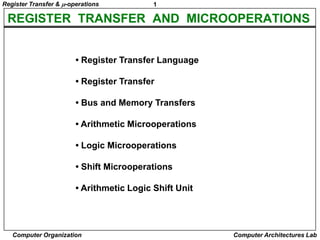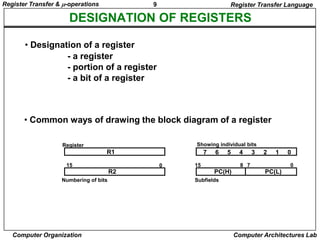The document discusses register transfer language and microoperations in digital systems. It defines microoperations as elementary operations performed on the information stored in registers. The key microoperation types are register transfers, arithmetic operations, logic operations, and shift operations. Register transfer language is used to describe sequences of microoperations that implement functions in a digital system by specifying operations on registers and transfers of data between registers.





















![Register Transfer & -operations
22
Bus and Memory Transfers
MEMORY READ
• To read a value from a location in memory and load it into
a register, the register transfer language notation looks
like this:
R1 M[MAR]
• This causes the following to occur
– The contents of the MAR get sent to the memory address lines
– A Read (= 1) gets sent to the memory unit
– The contents of the specified address are put on the memory’s
output data lines
– These get sent over the bus to be loaded into register R1
Computer Organization
Computer Architectures Lab](https://image.slidesharecdn.com/co4-140220233041-phpapp02/85/Computer-organiztion4-22-320.jpg)
![Register Transfer & -operations
23
Bus and Memory Transfers
MEMORY WRITE
• To write a value from a register to a location in memory
looks like this in register transfer language:
M[MAR] R1
• This causes the following to occur
– The contents of the MAR get sent to the memory address lines
– A Write (= 1) gets sent to the memory unit
– The values in register R1 get sent over the bus to the data input lines
of the memory
– The values get loaded into the specified address in the memory
Computer Organization
Computer Architectures Lab](https://image.slidesharecdn.com/co4-140220233041-phpapp02/85/Computer-organiztion4-23-320.jpg)
![Register Transfer & -operations
24
Bus and Memory Transfers
SUMMARY OF R. TRANSFER MICROOPERATIONS
A B
Transfer content of reg. B into reg. A
AR DR(AD)
Transfer content of AD portion of reg. DR into reg. AR
A constant
Transfer a binary constant into reg. A
R1,
R2 ABUS
ABUS
Transfer content of R1 into bus A and, at the same time,
AR
DR
M[R]
M
transfer content of bus A into R2
Address register
Data register
Memory word specified by reg. R
Equivalent to M[AR]
DR M
M DR
Computer Organization
Memory read operation: transfers content of
memory word specified by AR into DR
Memory write operation: transfers content of
DR into memory word specified by AR
Computer Architectures Lab](https://image.slidesharecdn.com/co4-140220233041-phpapp02/85/Computer-organiztion4-24-320.jpg)




















